History of the Company
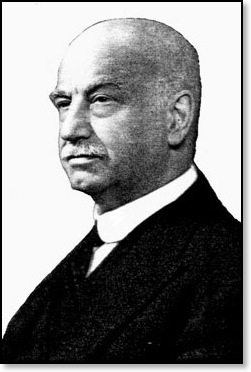
The Governor
Herbert Austin was born on 8th November 1866 at 3, Mill Cottages Little Missenden, Buckinghamshire, England. His father, a farmer, was Giles Stevens Austin and his mother was Clara Jane Simpson.
He was educated at Rotherham Grammar School and Brampton Commercial College, where he studied Architecture. Aged sixteen he emigrated to Melbourne, Australia, to join an uncle who was Works Manager of Langlands Foundry, a Melbourne engineering firm. During the following years he worked with various engineering companies, the last one being a subsidiary of the Wolseley Company of Great Britain.
He married Helen Dron, daughter of James Dron on 26th December 1887 in Melbourne. Herbert Austin, later had two daughters, and a son who was killed in France in the First World War. At the age of 27 he had an invitation from Frederick Wolseley to return to Birmingham, England, to supervise the manufacture of sheep shearing equipment.
He always had a passion for cars, partly because the long journeys into the Australian outback gave him an insight into the need for petrol driven vehicles. Two years on he built a tiller-steered three wheeler car.
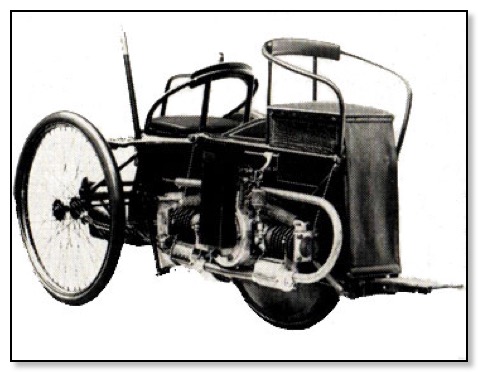
Wolseley Autocar 1895
Spurred on by this vehicle he carried on experimenting with various designs. It was in 1900 he won first prize in the 1,000 Mile Great Britain Trial with a four wheeler vehicle powered by a horizontal single cylinder engine. In 1901 the Wolseley Tool and Motor Car Company was founded at Adderley Park, Birmingham, with Herbert Austin as Manager. Under his direction Wolseley cars of the next few years won international renown. In the early summer of 1905 he resigned and looked around for somewhere to start up on his own?
After various exploratory rides around Birmingham. He came to Longbridge, where he found a small derelict tin printing works, which proved to be just what he wanted. It was situated beside the Bristol Road, the River Rea and the joint Great Western Railway line from Longbridge to Halesowen. The asking price was £10,000, but after some haggling a price of £7,750 was agreed. Thus the Austin Motor Company was born with £20,000 pounds capital, financial help having been secured from friends.
Although the purchase of the site and buildings actually took place on 26 January 1906, Austin had already installed himself and his staff in the empty buildings and was at work well in advance of that date.
By the end of 1905 he had shown plans of his first car at the Olympia Motor Show. The first car produced in 1906 was a 25 hp Endcliffe Phaeton costing £650.
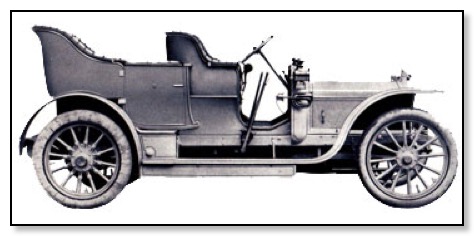
Endcliffe Phaeton
With orders picking up, his workforce of skilled craftsmen increased and in that year made 120 cars. One reason that he was able to get a new car to the market place so quickly was because he was multi-talented, a draftsman, skilled engineer and having marketing expertise.
In 1913 he decided to start making trucks. The first example being in the 2-3 ton range. This venture was short lived; having produced about 2,000 in total, Austin decided to concentrate on cars.
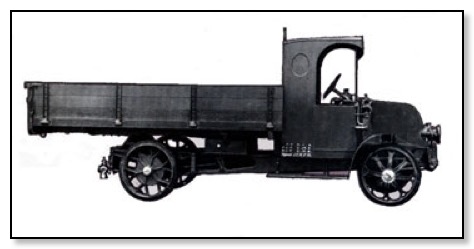
3 Ton Lorry
In February 1914 the Company changed from private to public ownership and the capital was increased to £50,000. In that year he produced about 1000 cars with 2,000 employees. It must have seemed at the time that he now had the capital to move the company forward. But his vision was short lived, as in August the First World War began. By September all the resources of the factory were harnessed to turn out munitions. The armed forces’ appetite for weapons and equipment of every kind increased so much that the factory expanded accordingly, but this also gave rise to a lack of workers that could get to the site both day and night. (Austin Village)
The next few years saw an explosion in size to the factory so that by 1918, mainly due to the war effort there were 20,000 plus employees mostly women. North Works (Longbridge Lane) had been built along with the West Works (Bristol Road). South Works now stretched back as far as the Birmingham-Gloucester railway line. It even had its own flying ground on a flat-topped hill south of the main works. Products leaving the factory during this period included 2,000 trucks, armoured cars, ambulances, generators, searchlights, 2,000 fighter aircraft and 6,500,000 shells.
For his services to the war effort in 1917 he was knighted, becoming Herbert Austin KBE, and was also awarded the Commander of the Order of Leopold of Belgium. In recognition of his engineering skills he became a Member of the Institute of Mechanical Engineers M.I.Mech.E. Herbert Austin had become interested in politics and was elected MP for the King’s Norton division of Birmingham as an Unionist (Conservative) in 1918, an office he held for six years.
At the end of the First World War all Government contracts were cancelled, leaving Austin with 20,000 employees and little work. The factory returned mainly back to producing cars, with the Austin 20 been the first vehicle to be put into production.
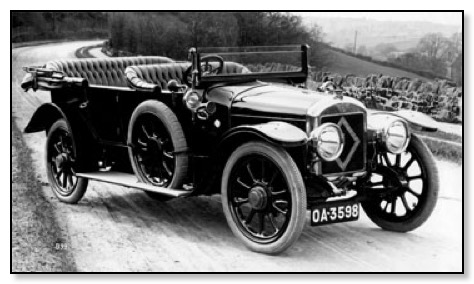
Austin 20HP Vitesse
Production of the Whippet and Kestrel light aircraft ceased in 1920. It was necessary to reduce the workforce accordingly. Sales of the 20hp were disappointing, so in 1921 a smaller version was rushed into production and called the Austin 12. This proved to be a very popular model and could be seen in London as taxicabs. Cost of the four seater touring version was priced at £550.
These two models did not raise sufficient cash flow to maintain the factory, administrators were called in to help turn the Company round. As the situation got worse the day came when Austin had to decide if the factory gates should be closed for the last time, or if he should put an alternative plan to the workforce.
The story goes that in order to make the decisions. Herbert Austin took a coin from his pocket and tossed it in the air, heads to stay, tails to close. It landed heads up, so Austin spoke to the workforce himself. He explained that the Company finances were not healthy, but that the problems could be overcome. He required help from the workers though. If they were prepared to work for one month without pay, the Austin Motor Company could survive. Herbert Austin appreciated that he could not ask this of the workers without giving something in return and he offered those making the sacrifice a job for life as long as the Company was there. That coin, a half crown was mounted in the wooden panelling behind his desk.
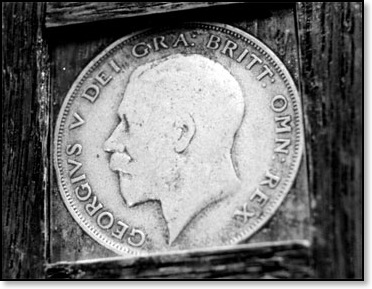
In 1922 the immortal Austin Seven was introduced; thus a whole new class of small car was born. Because of demand, major expansion took place, including the introduction of a flow-line system and the use of conveyors.
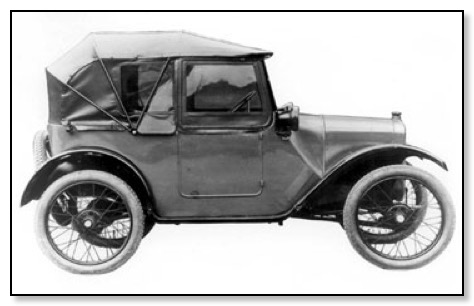
Austin Seven
Car production continued and it was not till the 1925s that it was time to expand the factory yet again. It grew to 62 acres and gave employment to 8,000 workers who annually produced 25,000 cars. Longbridge was now a great engineering centre with its own foundry, forge and machine shops. It had its own body pressing, assembling and painting plant, it had its own erection shops building engines, gearbox, rear axle and steering, as well as facilities for the final assembly of the finished car.
In the 1936 Honours List Sir Herbert Austin was created a Baron and elevated to the peerage. He took the title of Lord Austin of Longbridge. At the age of 69 he accepted the Chairmanship of the Government-sponsored shadow factory scheme for aircraft production, and during the next few years devoted much time to his new responsibility. Therefore because of this the East Works was built for assembling aircraft, including aero engine test cells and other facilities. The first aeroplane to be built was a Fairey Battle shown below. Click here for more information
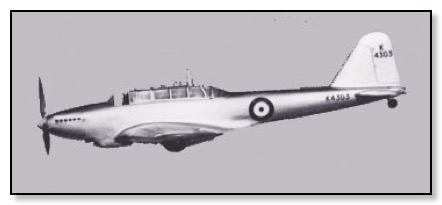
Fairey Battle
In March 1938 Leonard Lord joined the Company as Works Director. At the early age of forty-two, having been Managing Director of the Morris, Wolseley and M.G. company he had earned respect for his management skills. It was also decided to re-enter the light commercial vehicle field with a complete new range in January 1939. As the shape reflected the contemporary Bedfords of the time these became known as the "Birmingham Bedfords".
The most popular car produced at Longbridge at this time was the Austin Seven. In 1939 the 8HP version was introduced, and continued until 1947. A 10HP version came in 1939 and paralleled the 8HP until 1947. At the same time as the 10HP version a 12HP version was announced in August 1939, just before the second World War.
With the outbreak of war the factory soon had to change production to supply the war effort. The same machines and hands that a short time previously turned out highly finished cars took in their stride the production of a whole miscellany of intricate parts for the nation's war machine. The variety and quantities of articles produced were staggering, from steel helmets to aircraft and everything in between.
Lord Austin died on May 23rd, 1941, after a short illness at the age of 74, and is buried in Holy Trinity Church, Rose Hill North Worcestershire usually called “Lickey Church”.
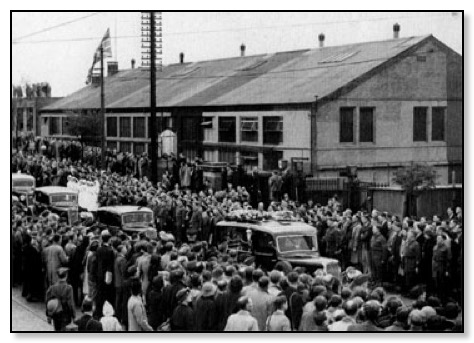
The funeral procession passing 'K' gate.
E. L. Payton, interim chairman then retired four years later on November 28th, 1945, whereupon Leonard Lord became Chairman and Managing Director.
In 25th June 1946 the First Millionth car was produced. In the following year the A40 Devon was introduced. By 1950 annual production had reached 157,628 units. The new Car Assembly Building (CAB 1) was officially opened in July 1951, and the A30 made its debut with the New 'A' Series engine.
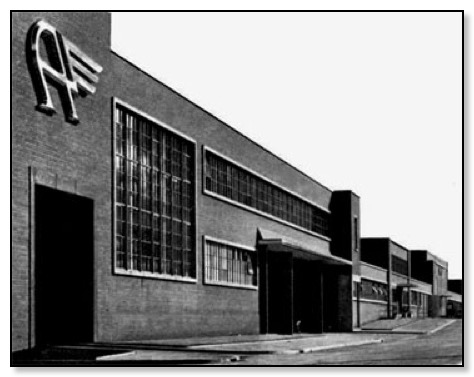
CAB 1
By 1952 the Company's factory site now covered 250 acres, with over 19,000 employees. In July of that year the British Motor Corporation (BMC) was born, with a merger of the Austin and Nuffield Organisations, enabling Britain's two leading manufacturers to pool experience and productive capacity. Austin was the dominate partner and so Longbridge became the headquarters. An agreement was made with the Donald Healey Motor Company to produce Austin Healey 100 sports cars. On 23 November 1953 the second millionth car was produced. 1954 was quite significant in that an agreement with the Nash Corporation of America produced the Nash Metropolitan, which used the running gear of the A40 Devon powered by the ‘B’ Series 1200 engine. Also launched was the A40/A50 Cambridge.
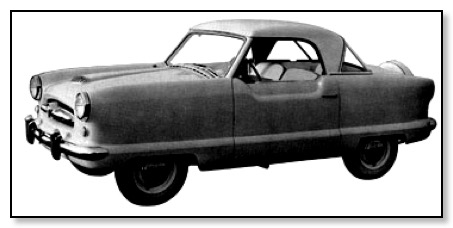
Metropolitan
The next few years saw the largest investment ever since the war, with the following projects: a headquarters building which was known by the workforce as the “Kremlin”, housing the senior management on the top floor; on the ground floor were garages, which housed their personal cars, but also, prototypes, along with a photographic studio. When the new Design Office was built in 1961 a covered way connected it to the “Kremlin”. At the back of this building was the Styling Studio where clay models were created. A good many photographs of styling concepts, or prototypes were taken in this building, or outside in a courtyard.
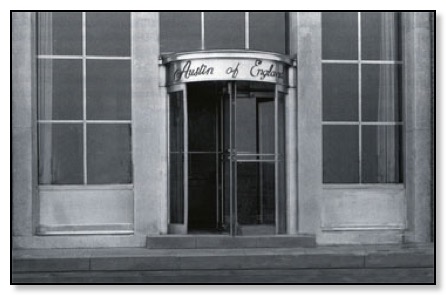
Main entrance to the 'Kremlin'
The building housing Lord Austin’s office by “K” gate needed to be demolished in 1957 to make way for a new machining shop, called No 5, and the South Engineering Block on the Lickey Road by the Island. All the contents of “The Office” were carefully removed and installed in the South Engineering Block and remained there until early 2003 when it was relocated to the Conference Centre and archive centre, formerly known as the Exhibition Hall by “Q” gate.
At this time on the Bristol Road (North Car Park) a Large chevron sign showed an aerial picture of the factory, and in large print were the words “The Largest Self Contained Car Factory in the World”, No idle boast, as most of the components needed in the making of a car came in as raw materials. This was a far cry from today’s production, when most items come to a car factory as sub-assemblies, with the various suppliers producing items locally and delivering them to the factory in what is currently called Just In Time (JIT).
1955 heralded the 50th anniversary of the Longbridge plant. Leonard Lord laid the foundation stone for the new Sales Block and Exhibition Hall, which included a restaurant for staff and visitors.
To give some idea of the scale of operations at Longbridge in the mid 50s. It employed 21,000 employees which produced annually over 193,000 vehicles. The plant consumed nearly 75,000 tons of coal along with 1.7 million gallons of oil for electricity generating and producing steam for the miles of heating pipes. Water consumption over the whole site was 350 million gallons. It had a Telephone exchange staffed by 10 operatives and the number you rang was PRIORY 2101
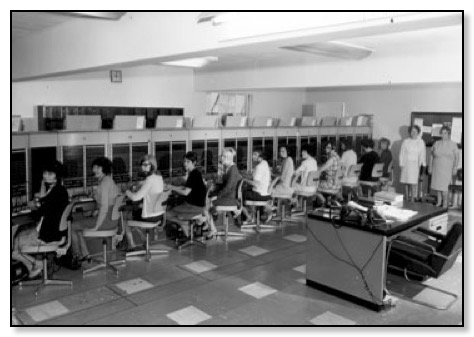
Telephone Exchange
It had a modern Health Department built as a memorial to the late Lord Austin, including X-ray apparatus, deep ray and radiant heat equipment. There were two resident medical officers, and two specialists attended two or three times a week. There were two dentists and a technician, there were 8 Ambulance stations around the plant manned by 25 qualified nurses, so an employee was never more than 10 minutes away from medical attention. Operated in close association with the Health Department was a Rehabilitation workshop. Here injured workers could exercise stiff limbs, and at the same time do a useful paid job of work by operating light machines fitted with special manual or foot controls. To feed the workers there were 16 Dining rooms and 4 snack bars, which alone employed 215 staff. It employed 69 Works Police along with 33 Firemen. The internal Post Office despatched per week over 52,000 letters and postcards along with 1,500 parcels. To handle this quantity of mail it employed 11 postmen, who had set routes around the factory delivering and collecting at least twice a day. The address was just Austin Motor Company PO Box 41 Longbridge Birmingham, the PO box number never changed only the name of the company in the 100 years.
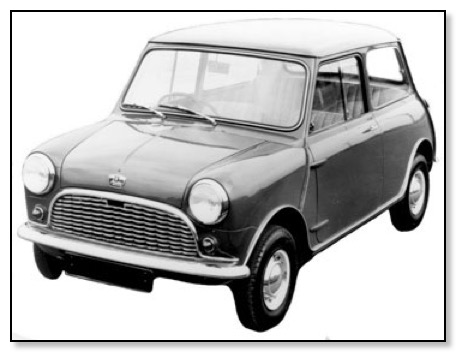
Mini (ADO15)
The next milestone was the introduction of the Mini (ADO 15) in August 1959. Although production of the Mini was shared between Longbridge and Cowley, the entire transfer power unit came from East Works. As part of the preparation for the engine/gearbox components, part of East works was cleared for the new transfer machinery, which were Austin designed and produced in North Tool-Room. Trucks and 4 x 4 Gipsy were also being made there at the Cofton Hacket end of the shop along with CKD.
As part of the plan to increase production of the Mini work started in 1960 on a new Car Assembly Building (CAB 2)
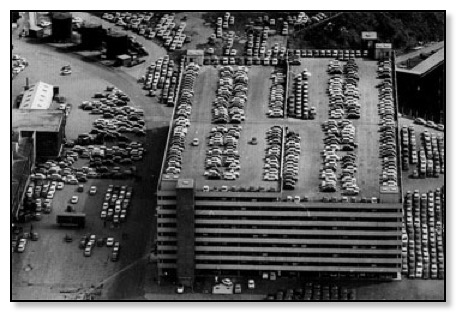
Multi-Storey Car Park
To house increased production at the factory in 1961 a multi-storey car park with a total capacity of about 3,300 was built to house the vehicles before dispatch. This was nine storeys high and measured 114m long and 62m wide and at the time was the largest in the world. The construction used was unique in that it would be built by the Slab process developed by a American company and licensed in the UK by the Wimpy.
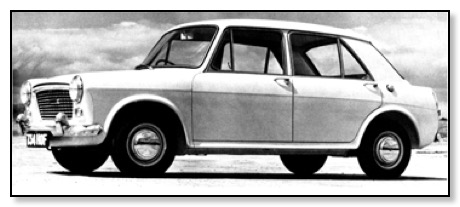
Austin 1100 (ADO16)
It was in the summer of 1962 that the Morris version was launched. CAB 2 was up and running so for a time the Morris 1100 was been produced at Cowley and Longbridge. In 1963 the Austin version of the 1100 was launched and production at Longbridge became 100% Austin.
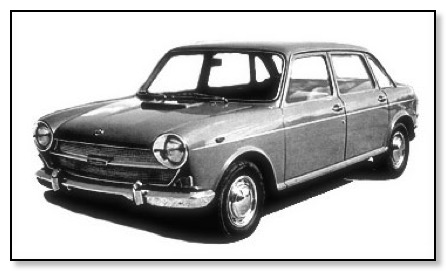
Austin 1800 (ADO17)
The next milestone was the Austin 1800. This car at the time had the most spacious passenger cabin of any car on the British market all in a length of 13ft 8in. It was not long before it got the nickname Land-crab.
BMC in July 1966 changed its name to British Motor Holdings (BMH) with Sir George Harriman as chairman, On the 17th January 1968 BMH was effectively taken over by Leyland Motors, and yet another name change to British Leyland Motor Corporation.This lead to a changes of management, with Sir Donald Stokes running what was now to be called Austin-Morris. George Turnbull (Managing Director) and Harry Webster (Technical Director)
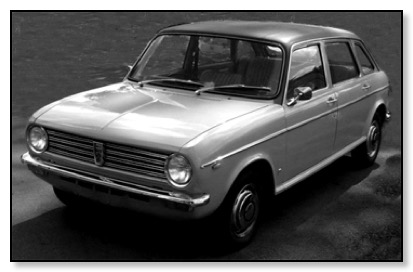
Austin Maxi (ADO14) Cowley Build
The next major launch was the Austin Maxi (ADO14) although it was badged as an Austin, all production took place at Cowley.. One of the main features of the Maxi which came out for the 1970 Motor Show was the all new E series 1485cc and 1748cc engine. In 1977 the Austin name was dropped and it was renamed Maxi 1500. The engine/gearbox was produced in a new factory built behind East Works on a green field site.
British Leyland were now developing new models, the first on the scene was the Morris Marina (ADO 28). Although assembled at Cowley all the engines and gearboxes were made at Longbridge. In the last few months of its life, production was transferred to Longbridge.
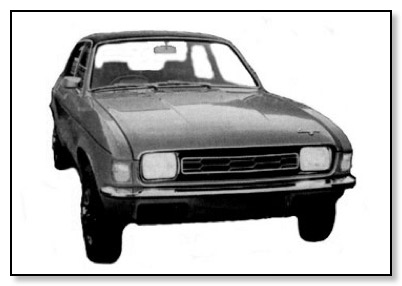
Austin Allegro (ADO67)
The Allegro was designed as the replacement for the popular 1100/1300 range, using the both the 'A' and 'E' Series engines. The design of the body was more rounded than the model it replaced. One distinguishing feature was the "quartic" steering wheel which was not popular and soon dropped. Various versions were made including an Estate, a Sports which had gaudy side strips was assembled in Belgium and sold in the UK.
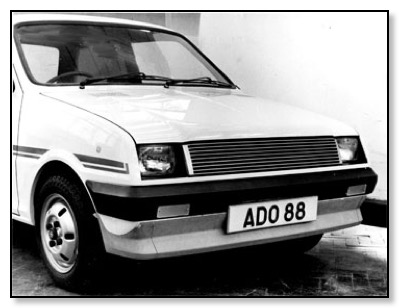
Austin Mini Metro (LC8)
In the October of 1980, British Leyland introduced the Austin Mini Metro, the word Mini was soon dropped after launch. In the prototype form it was known as ADO 88. The Chairman at the time was Michael Edwardes who had taken up this appointment in November 1977. Every body working on the ADO88 were unhappy with the way it was working out, the project launch date was October 1979. The new chairman having tried the car also felt that it was not sufficiently refined and that the styling was more akin to a van. So the LC8 was born (LC standing for Leyland Cars) the intention was that it would be a replacement for the Mini, which turned out not be the case. It would carry over as many components as possible to keep the cost down. The budget for LC8 was put at £270 million which included the building of the New West Works. When it first came out it was only available as a three door, which I felt was a mistake. At the time of its launch, the Metro was hailed as British Leyland's saviour, as the company was facing a serious financial crisis at the time and there were fears that it could go out of business. The name Austin was dropped at the end of 1989 and in 1990 became Rover Metro with the fitting of the 'K' series engine and later on in 1994 after a face lift it became the Rover 100.
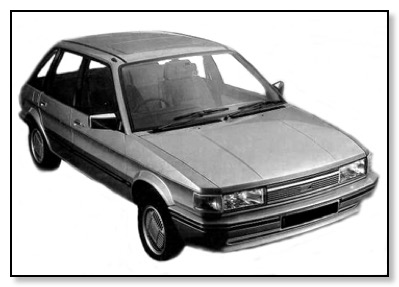
Austin Maestro (LC10)
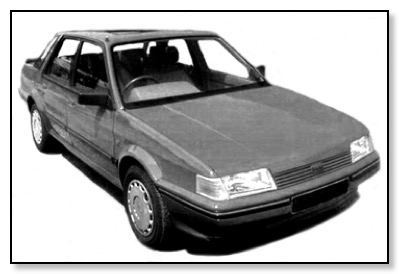
Austin Montego (LC11) Cowley Build
Both of these cars shared the same floor-pan and doors. The design of the Maestro started in 1977 and would be a five-door hatchback. One of the main features was the conventional MacPherson strut system. On the engine front it had a variety of types starting with the 'A' series at 1275cc the new 'R' series 1598cc. The 'R' series was only in production for about sixteen months, to be replace by the new 'S' series 1598cc in July 1984. Various features included a laminated windscreen as standard, body coloured plastic bumpers and a electronic engine management system (ECU). On the transmission front there was a departure in that a five speed Volkswagen gearbox was fitted. The original dashboard was on the flimsy side, but in early 1986 it was replaced with the Montego type.
Both of these cars shared the same floor-pan and doors. The design of the Maestro started in 1977 and would be a five-door hatchback. One of the main features was the conventional MacPherson strut system. On the engine front it had a variety of types starting with the 'A' series at 1275cc the new 'R' series 1598cc. The 'R' series was only in production for about sixteen months, to be replace by the new 'S' series 1598cc in July 1984. Various features included a laminated windscreen as standard, body coloured plastic bumpers and a electronic engine management system (ECU). On the transmission front there was a departure in that a five speed Volkswagen gearbox was fitted. The original dashboard was on the flimsy side, but in early 1986 it was replaced with the Montego type.
Montego was launched in April 1984 an estate version arrived on the scene later in the year, and proved to be a good seller. A seven seater version was available with two rear facing child seats and self-levelling rear suspension. 'O' series engines arrived on the scene and also the economical Perkins diesel which had the Honda PG1 gearbox.
The company was sold by the Government in 1986 to British Aerospace and in the following year end, both Maestro and Montego lost the Austin badges. The models stayed on in production, but in 1993 were finally phased out to make way for the Rover 600 (Honda).
THE END

